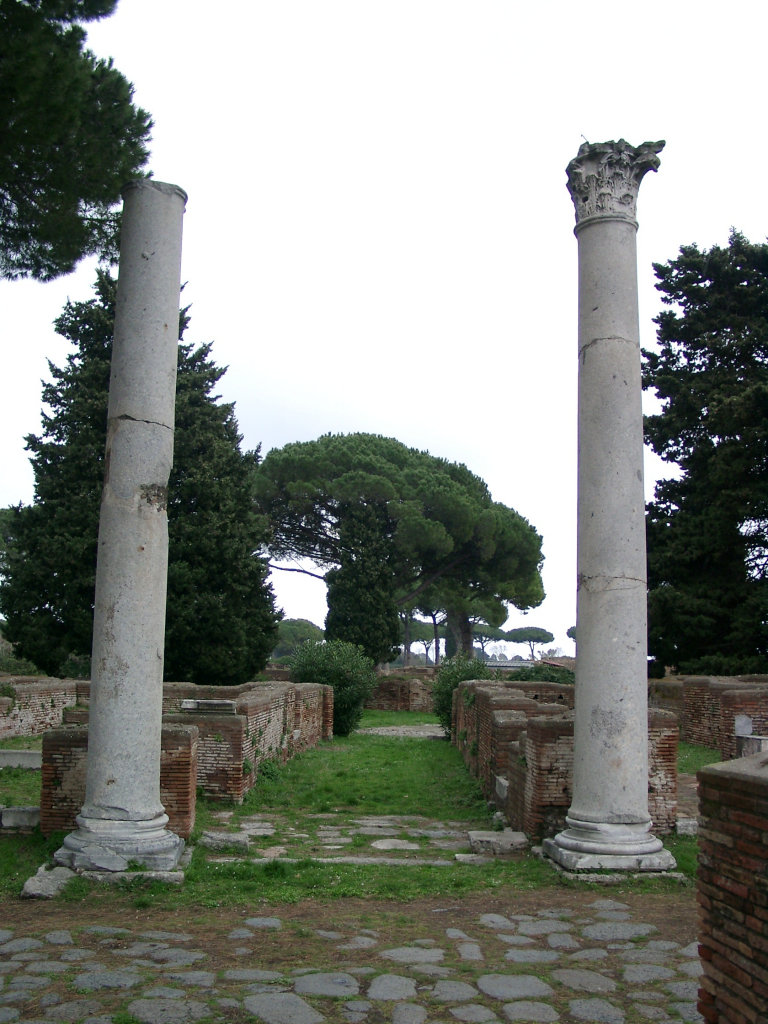|
The Macellum, a central market for fish, meat and vegetables, was excavated in 1938. Restorations were carried out in 1942. Further excavations took place in 1949-1953, by the Soprintendenza, and in 1997-2001, by the University of Augsburg. Most of the masonry belongs to the later second century, probably to the reign of Commodus (180-192 AD; opus latericium). Below the building remains were found of a building from the first half of the third century BC (destroyed by a fire), and of a late-Republican building (c. 70-30 BC), possibly a domus, also destroyed by a fire. If there really was a domus under the present ruins, then the Macellum may originally have been elsewhere in the city. Some Augustan masonry (shops) was found below the east half of the courtyard. The building is dominated by a courtyard. It could be reached directly from Via del Pomerio to the east, through two entrances two metres wide. The entrances were closed with wooden doors, witness the thresholds. The courtyard could also be reached from the north, from the Decumanus. Here is a monumental entrance, a porch with two granite columns. A corridor leads to the interior. Further to the west is a secondary corridor, with a white mosaic. The north part of the building consists of shops. Some are behind porticoes along the Decumanus and Via del Pomerio, others face the courtyard. In the second shop to the east of the main corridor, on the Decumanus, is a masonry counter that partly blocks the entrance. It was decorated with marble. In the front is a niche. A north-south running wall was set against the counter. There are two staircases in this part of the building. In the northern porticus the Shops of the Fishmongers (IV,V,1) were installed. To the south-west of the courtyard is a large room, perhaps with a barrel-vault, where standard weights and measures may have been kept. To the west of the courtyard is a deep podium, that originally had a roof. It was supported by brick piers set against the back wall, and by six marble columns with Corinthian capitals set against the front of the podium. The podium could be reached from the courtyard along little staircases. Two staircases in the centre lead downward to a room below the podium. In this room are a few small basins. The marble columns were found partly in the building and partly in the neighbourhood, reused in other structures in late antiquity. On one of the columns is the inscription or rather graffito:
The text is written lengthwise and must have been chiseled when the column had collapsed. The column was found reused in Nymphaeum I,XIV,1, and was placed on the podium in 1942. Lege et intellige is a Christian formula. The text must be a reference to a miracle. The central part of the courtyard (c. 28 x 22 metres) was paved with marble. It is surrounded by a gutter, around which runs a second, travertine gutter. In the centre is a rectangular basin, the short sides of which are curved. It was revetted with marble. Inside a marble statue of a putto on a dolphin was found, very similar to a statue found near Nymphaeum I,XIV,1, across the street. Perhaps only the wings around the central area had a roof. The east wall of the courtyard was built in the late fourth or early fifth century AD. In the same period niches in the south wall were blocked (opus latericium). In the north-east porticus two furnaces for the production of glass vessels were found, together with many glass sherds and waste products. The ovens are also additions from the late fourth or early fifth century. A macellum is mentioned in several Ostian inscriptions. One of these was found in 1824 on the Forum. It has not been dated:
A market and standard weights and measures (pondera) are mentioned. There may be a reference to the city of Tharros on Sardinia. Standard measures made of marble can today still be seen in the Christian Basilica (III,I,4) and House of the Harbour Mosaic (I,XIV,2), to the west and north of the Macellum. Pondera were also placed in the Macellum by Publius Lucilius Gamala and Marcus Turranius in the first century BC:
In the early first century AD the market was restored by a freedman of Augustus, Nymphodotus, with one of his freedmen, Caius Iulius Pothus. Fragments of the inscription were found in various buildings near the Macellum (EDR031488). In the second half of the second century weights were supplied by Publius Lucilius Gamala, in imitation of his ancestor from the first century BC:
This gift may be related to the rebuilding of the market under Commodus. Finally the market is mentioned in an inscription from the years 418-420 AD. It was now restored, with pondera, by Symmachus, Praefectus Urbi:
|
 Plan of the market. After SO I. |






